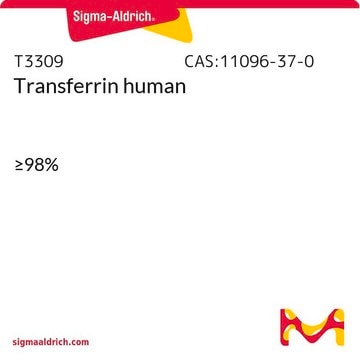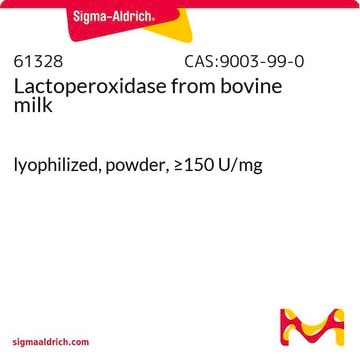The molecular weight of this product is approximately 80 kDa.
L1294
Lactoferrin human
recombinant, expressed in rice, Iron saturated, ≥90% (SDS-PAGE)
Synonim(y):
Holo Transferrin
Wybierz wielkość
895,00 zł
Wybierz wielkość
About This Item
895,00 zł
Polecane produkty
pochodzenie biologiczne
human
rekombinowane
expressed in rice
typ
for cell culture
Próba
≥90% (SDS-PAGE)
≥90% (biuret)
Formularz
powder
metody
microbiological culture: suitable
zanieczyszczenia
≤10 EU/mg endotoxin
numer dostępu UniProt
temp. przechowywania
2-8°C
informacje o genach
human ... LTF(4057)
Szukasz podobnych produktów? Odwiedź Przewodnik dotyczący porównywania produktów
Zastosowanie
Działania biochem./fizjol.
Kod klasy składowania
11 - Combustible Solids
Klasa zagrożenia wodnego (WGK)
WGK 3
Temperatura zapłonu (°F)
Not applicable
Temperatura zapłonu (°C)
Not applicable
Środki ochrony indywidualnej
Eyeshields, Gloves, type N95 (US)
Wybierz jedną z najnowszych wersji:
Certyfikaty analizy (CoA)
Nie widzisz odpowiedniej wersji?
Jeśli potrzebujesz konkretnej wersji, możesz wyszukać konkretny certyfikat według numeru partii lub serii.
Masz już ten produkt?
Dokumenty związane z niedawno zakupionymi produktami zostały zamieszczone w Bibliotece dokumentów.
Klienci oglądali również te produkty
-
what is the molecular weight of L1294, Lactoferrin human?
1 answer-
Helpful?
-
-
Do you have a recommendation for storage after dissolving in H2O? I cannot find any handling instructions online.
1 answer-
The stability of this item has not been tested once it is in solution. It is recommended to make fresh before using the item.
Helpful?
-
-
What is the sequence of this product? Do you have the half (1-11) peptide product?
1 answer-
L1294, Lactoferrin human, has the exact same amino acid sequence as the native protein. Unfortunately, we do not supply human lactoferrin peptide hLF1-11.
Helpful?
-
Active Filters
Nasz zespół naukowców ma doświadczenie we wszystkich obszarach badań, w tym w naukach przyrodniczych, materiałoznawstwie, syntezie chemicznej, chromatografii, analityce i wielu innych dziedzinach.
Skontaktuj się z zespołem ds. pomocy technicznej












